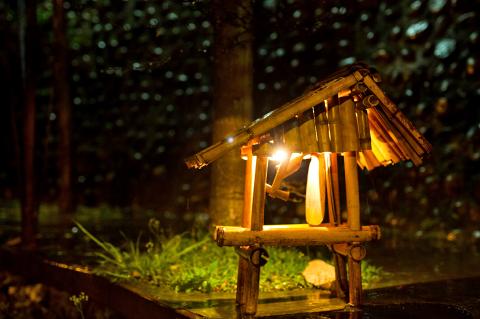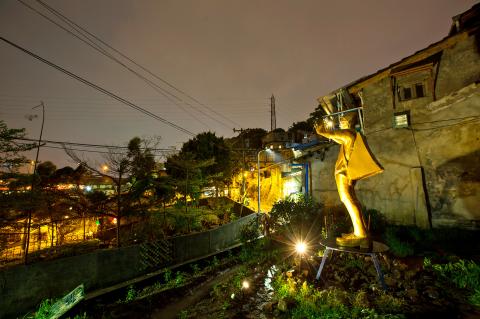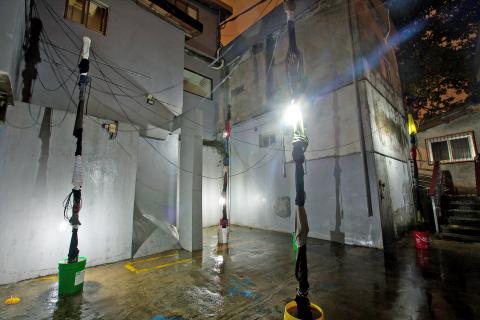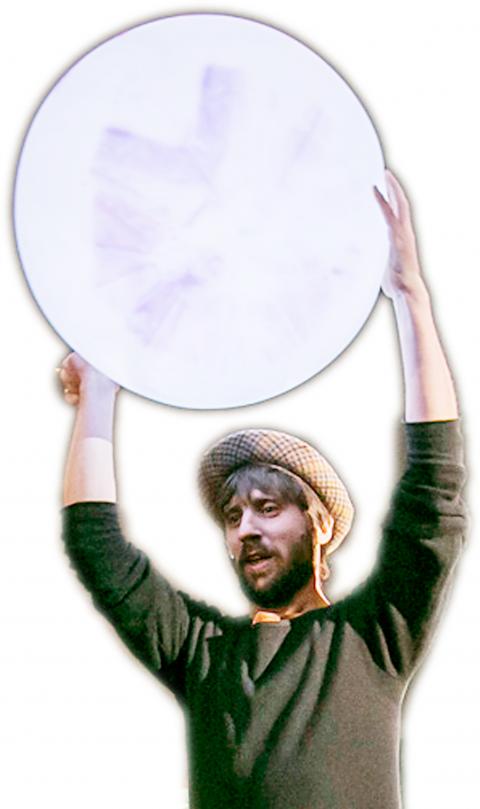Do not expect there to be real lanterns at the Treasure Hill Environmental Art Lantern Festival (寶藏巖環境藝術燈節), set to open at 7pm tomorrow at Taipei’s Treasure Hill Artist Village (寶藏巖國際藝術村). Instead, installations will illuminate the hills, creating a pensive mood for visitors to contemplate the controversial history of this now popular cultural attraction.
Launched in 2012, the annual festival features performances and installations by contemporary artists from Taiwan and Japan, some of whom were former artists-in-residence.
“We don’t come up with a theme and give it to the artists. The artists have to come here and examine the place first, and then start to think about what they want to do,” says Yang Hsiao-wei (楊筱薇) from the Taipei Culture Foundation’s Department of Artist-in-Residence (台北市文化基金會藝術村營運部).

Photo courtesy of Taipei Culture Foundation
While there is no thematic focus, crossover collaborations feature predominantly in this year’s lineup. For the festival’s opening show, multimedia artist Chou Yu-cheng (周育正) creates a large tent-like structure as the set for a performance by Scarecrow Contemporary Dance Company (稻草人現代舞蹈團).
Building a stage with recycled clothing, artist Chen Sung-chih (陳松志) collaborates with dancer-choreographer Yu Yen-fang (余彥芳) from the improvisational dance troupe Ku & Dancers (古舞團), for a performance on April 18 and April 25.
HISTORICAL BENT

Photo courtesy of Taipei Culture Foundation
Once a squatter community whose inhabitants were primarily war veterans who retreated to Taiwan with the Chinese Nationalist Party (KMT), Treasure Hill was designated a historical site in 2004. It underwent renovations by the Department of Cultural Affairs in 2007. Most of the tenants were relocated, with only a few remaining. The artist village was officially put into operation in 2010.
Tai Han-hong’s (戴翰泓) wobbly wood-and-iron structure is inspired by the inhabitants’ persistence despite repeated relocation attempts.
Yet Luo Jr-shin’s (羅智信) work is probably the most critical. Transforming an old, above-ground cistern into a swimming pool with a beach chair on the side, Luo intends to show how the squatter settlement became a weekend hot spot frequented by camera-wielding visitors. Sound artist Betty Apple (鄭宜蘋) will perform in the pond on April 6 and April 11.

Photo courtesy of Taipei Culture Foundation
The exhibited artworks are scattered throughout Treasure Hill’s labyrinth of piecemeal buildings, so visitors are encouraged to wander through the alleys. The best time to visit is after sunset since most of the installations use light as one of their creative elements.
All live performances are scheduled to take place on weekends, free of admission. For more information, visit www.artistvillage.org or www.facebook.com/artthav.

Photo courtesy of Taipei Culture Foundation

On April 26, The Lancet published a letter from two doctors at Taichung-based China Medical University Hospital (CMUH) warning that “Taiwan’s Health Care System is on the Brink of Collapse.” The authors said that “Years of policy inaction and mismanagement of resources have led to the National Health Insurance system operating under unsustainable conditions.” The pushback was immediate. Errors in the paper were quickly identified and publicized, to discredit the authors (the hospital apologized). CNA reported that CMUH said the letter described Taiwan in 2021 as having 62 nurses per 10,000 people, when the correct number was 78 nurses per 10,000

As we live longer, our risk of cognitive impairment is increasing. How can we delay the onset of symptoms? Do we have to give up every indulgence or can small changes make a difference? We asked neurologists for tips on how to keep our brains healthy for life. TAKE CARE OF YOUR HEALTH “All of the sensible things that apply to bodily health apply to brain health,” says Suzanne O’Sullivan, a consultant in neurology at the National Hospital for Neurology and Neurosurgery in London, and the author of The Age of Diagnosis. “When you’re 20, you can get away with absolute

May 5 to May 11 What started out as friction between Taiwanese students at Taichung First High School and a Japanese head cook escalated dramatically over the first two weeks of May 1927. It began on April 30 when the cook’s wife knew that lotus starch used in that night’s dinner had rat feces in it, but failed to inform staff until the meal was already prepared. The students believed that her silence was intentional, and filed a complaint. The school’s Japanese administrators sided with the cook’s family, dismissing the students as troublemakers and clamping down on their freedoms — with

As Donald Trump’s executive order in March led to the shuttering of Voice of America (VOA) — the global broadcaster whose roots date back to the fight against Nazi propaganda — he quickly attracted support from figures not used to aligning themselves with any US administration. Trump had ordered the US Agency for Global Media, the federal agency that funds VOA and other groups promoting independent journalism overseas, to be “eliminated to the maximum extent consistent with applicable law.” The decision suddenly halted programming in 49 languages to more than 425 million people. In Moscow, Margarita Simonyan, the hardline editor-in-chief of the